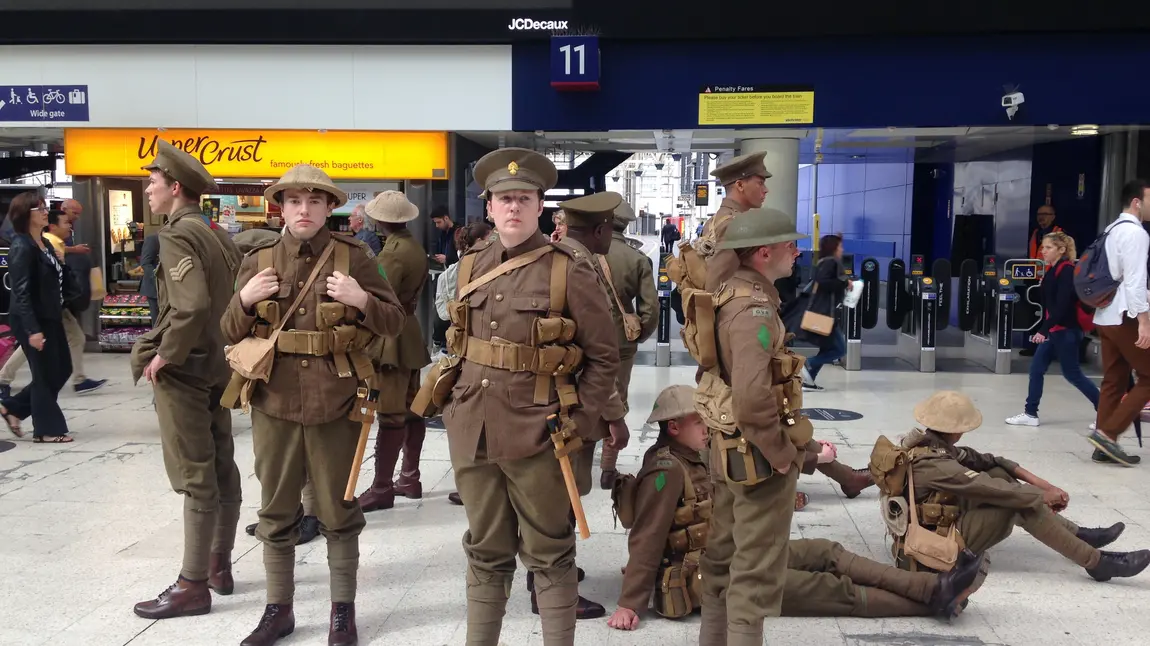We’re here because we’re here

Public perceptions of the Centenary
Ever since I started as an intern at Imperial War Museums back in 2011, I have been hooked on the history of the First World War. I’m particularly interested to see how the Centenary of the conflict is being marked around the world 100 years on. It’s been fascinating to watch the public reactions to the events, activities and performances I have been lucky enough to attend.
Back in 2014 I saw a play about Vesta Tilley, 'Britain's best recruiting sergeant’. She was the much-loved male impersonator who encouraged thousands of men to enlist through her music-hall performances. The audience, many of whom were young people, roared with laughter as Vesta danced and sang her way through the show, representing a host of characters.
[quote]"During the Centenary, people of all ages and backgrounds have been inspired, intrigued, dismayed, horrified and moved by the stories of the First World War."[/quote]
During the Centenary, people of all ages and backgrounds have been inspired, intrigued, dismayed, horrified and moved by the stories of the First World War.
The Battle of the Somme seems to induce a deep sadness in people. The colossal losses of the campaign which lasted 141 days, and the imagery of those volunteers recruited in 1914 going ‘over the top’, has made it one of the most notorious battles in history. It has come to represent how many people envisage the First World War on the Western Front.
I was interested to see how HLF grantees would respond to the Somme anniversary and engage audiences with this complex and affecting subject. I have not been disappointed. On 1 July 2016, 100 years from that fateful first day of the Somme, I had one of my most affecting experiences of the Centenary.
#wearehere
At 8am at Waterloo station I encountered around 100 young men, dressed in authentic First World War uniforms, who appeared as if from nowhere. They were completely silent. Some were smoking, some were drinking from water bottles and others were resting as if waiting for something to happen. I approached the youngest looking soldier and asked what he was doing. He looked at me directly, paused for a moment and with a resigned half-smile handed me a card that looked like a business card. It read:
Private C. Ross
2nd Battalion Gordon Highlanders
Died at the Somme on 1st July 1916
#wearehere
With a nod, he silently moved away and I was left feeling stunned. Moments later the 100 or so soldiers broke into song, singing "We’re here because we’re here" repeatedly, to the tune of Auld Lang Syne. Their voices filled the air of Waterloo station, which by that time of the morning was bustling with commuters. This was a vivid and poignant moment that I will never forget.
[quote]"Around 1,500 volunteers aged 16-41 took part in the project."[/quote]
This piece, entitled ‘We’re here because we’re here’, was conceived and created by Turner Prize-winning artist Jeremy Deller in collaboration with Rufus Norris, Director of the National Theatre. It was commissioned by 14-18 NOW, the UK’s cultural programme for the First World War Centenary. 14-18 NOW is supported by HLF thanks to National Lottery players.
Around 1,500 volunteers aged 16-41 took part in the project, representing just a fraction of the 19,240 men killed on 1 July 1916. They were not trained actors but came from a range of professions, including a sheep farmer, flight attendant, doctor, lawyer, social worker, shop assistant, artist and GCSE student.
Jeremy Deller said: “I wanted to make a contemporary memorial to mark the Centenary of the Battle of the Somme, one that moved around the UK with an unpredictability in which the participants, by their actions, took the memorial to the public.”
Later that day I travelled to Manchester and witnessed a similar scene at St. Ann’s Square, where passers-by stopped to observe the soldiers who stood in loose formation. In the time it took me to get out my phone to take a photo they had disappeared from the square and could be seen walking off in line, towards Oxford Road train station.
On both occasions, the most interesting thing was watching how the public interacted with the soldiers. Most people were visibly moved, many to tears, as they read their soldier’s card. Some were surprised and looked taken aback, whilst others barely gave them a second glance as they went on their way. The most common reaction was for people to stand back and watch the soldiers almost uncertainly from a distance, with some coming forward to take a photo or ask a tentative question. There were of course also a few who took ‘selfies’ with the soldiers.
One passer-by tweeted #wearehere is throat-tightening moving. A painful resurrection.
In addition to those who unexpectedly came across the soldiers in locations across the UK, thousands of witnesses posted tributes, notes of thanks and images online.
I have been thinking ever since about what it was that made all those people (including me) stop and think for a few moments on 1 July.
[quote]"#wearehere is throat-tightening moving. A painful resurrection."[/quote]
Firstly, I think the power of the performance itself was impressive. The volunteers stayed silent and in character, and avoided interacting with one another, except when singing. This was particularly obvious when I followed the group to Manchester Oxford Road station. They just seemed to know exactly where they were going. It was quite unnatural and eerie to watch a group behaving in that way.
Secondly, I think it was the poignancy of the anniversary. I overheard so many people saying "Oh…it’s for the Somme, of course!"
Ultimately, for me, it was actually coming face-to-face with the young men in their uniforms that allowed me to make a human connection to the events of 100 years ago. Instead of reading names on a war memorial and wondering who they might have been, I felt that I was looking into the eyes of someone who had really been there, and who had never made the return journey home. Whether they felt incredulous, moved, chilled or just empty, people couldn’t help but stop for a minute and reflect.
‘We’re here because we’re here’ demonstrates one of the many innovative ways that audiences can be engaged with the heritage of the First World War during the Centenary.
Get involved
Since April 2010, HLF has awarded nearly £80million to over 1,500 First World War projects right across the UK and funding is still available. If you have been inspired by this project or others you have come across, do consider applying for an HLF grant.
You might also be interested in...



